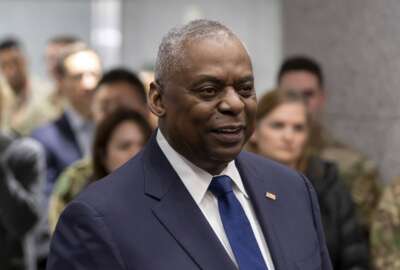On military policy, there’s not much daylight between Harris and Trump
"Now that we're in a new fiscal year 2025, we have again the dilemma of figuring out what our defense budget should be," Michael O'Hanlon said.
When you look closely, there’s not much difference between Kamala Harris and Donald Trump when it comes to military strategy and spending. That’s according to my next guest, who’s done a detailed comparison. Michael O’Hanlon is a former Defense Policy Board member, now a senior fellow at Brookings, joined the Federal Drive with Tom Temin.
Interview transcript:
Tom Temin And you have looked carefully at the policy positions, and also some of the track record of both candidates. And what’s your conclusion about what the military establishment, the Pentagon, can expect if either one of them is elected?
Michael O’Hanlon Thanks, Tom. Well, full disclosure, I am still currently on the Defense Policy Board for Secretary of Defense Austin, although that is a bipartisan or nonpartisan outside group. And there are a number of people of both political parties. I am a Democrat, but I’m particularly partisan and never have served in either administration. Secondly, I had an opportunity to consult with Secretary of Defense Jim Mattis as well as Mark Esper during the Trump years. So whatever role I’ve played, I hope is at least subjective as I can try to make it. And with that in mind, I’ve looked at the national defense strategies of each president and each secretary of defense, as well as the way they’ve resourced the military, where they’ve put their priorities, where they’ve emphasized technology, where they try to keep up with or get ahead of get further ahead of Russia and China. And the overall point is that, yes, they are pretty similar, especially because of the focus on Russia and China, which began really in the last two years of the Obama administration, but really picked up with Secretary of Defense Jim Mattis. And his strategy that was articulated and published in early 2018, which put a priority on Russia and China together, that followed from the national security strategy that H.R. McMaster had done for President Trump over at the White House a couple of months before at the end of 2017, which did that same thing.
Michael O’Hanlon It’s not clear how much Donald Trump himself was behind the authorship of either of these documents, or just how much he fully digested and supported these concepts. But certainly the Pentagon tried to reorient its modernization agenda, in particular around the idea of focusing on not so much Iraq, North Korea, Iran, Afghanistan anymore, as we had been for a quarter century, but the potential great power rivals. And that has continued very much in the Secretary of Defense, Austin and Biden tenures, and they admit it. They don’t admit it, they applaud it. I think it’s actually good for U.S. policy that we can sustain certain key themes, because it takes more than four years to change the Pentagon. And even now, almost eight years into this effort, we’re still not nearly as far along as we probably need to be. But yes, in terms of strategy, in terms of doctrine, in terms of budgetary resources, very similar. Obviously huge differences between the potential occupants of the White House in terms of their decision making style, how you imagine them looking at the world, their views towards alliances, their views towards crisis management. But their Pentagon doctrines and resource allocations are quite similar so far.
Tom Temin And I wanted to ask you about a detail of this, and that is something that both Democratic and Republican presidents pursued when the nation could, for lack of a better word, afford to do so. And that is arms control. And under Reagan and under Democratic presidents, there were arms control treaties to reduce nuclear weapons. Now we’re looking to renew the stockpile and refresh it in some manner. What do you see on that particular front?
Michael O’Hanlon We have a big challenge now, Tom in that not only is it hard to do business with Vladimir Putin while he’s bombarding cities in Ukraine and frontline positions there, but also we’ve got China rising up and deciding it wants to be in the major leagues of nuclear weapon states, which is a huge departure from anything China has done before. It was always content, sort of like our allies, Britain and France, to have a couple of hundred nuclear weapons. That’s probably about the number Israel has too. Not unlike the numbers that India and Pakistan have. But now China’s aiming, it appears, for 1500 warheads by the middle of next decade. And that raises the question, how do we do arms control? Historically, we’ve always wanted to have an equal number of strategic or long range weapons, as did the Soviet Union. And we applied that framework to the Russian Federation after the Cold War. But now are we content to only have as many as either Russia or China, and let them together out twice as many as we might? And counting Britain and France doesn’t really bring us up to snuff, even though they’re our allies because they have smaller arsenals than China appears to intend. So we really need a new intellectual framework. I don’t want to count Russia and China together. For one thing, they wouldn’t allow that. They’re not formal allies. But secondly, I don’t want to push China into Russia’s arms forever either. So we need a new framework. Amy Nelson at New America has good ideas on this. She and I have tried to do some writing together and propose emphasizing transparency in arms control rather than quantitative limits.
Tom Temin We’re speaking with Michael O’Hanlon, senior fellow at Brookings and a member of the Defense Policy Board. And in your essay on this, the comparison between Kamala Harris and Donald Trump, with respect to military doctrine and spending. Spending levels seem to go up or down, plus or minus some percentage a little bit above inflation, regardless of who’s in the White House. What do you expect for spending? Considering how small the Navy seems to be? How if we wanted to renew the nuclear warheads or increase the number of them, we don’t have the money to do everything. That seems to be a priority right now, including big troop pay increases.
Michael O’Hanlon Well, now that we’re in a new fiscal year 2025, we have again the dilemma of figuring out what our defense budget should be. And we don’t have one for 2025. Of course, Congress just averted a shutdown and asked to come back in December after the elections to devise a proper budget. That’s been the pattern for the last 15 years. Where the Pentagon, like every other federal agency, as you well know, has had to limp along with a continuing resolution, basically extending or extrapolating the previous year’s budget. And that’s meant you can’t get going on new programs, you can’t take them into a higher gear. You’re constantly four to six months behind where you had intended. So that’s a big problem. The amount of resources per se has not been the problem, because the defense budgets big. It’s not huge relative to GDP by historical standards. Just a little over 3% of gross domestic product, but it is about $850 billion a year. And even Vietnam era budgets, even Reagan era budgets, did not reach that level after adjusting for inflation.
Michael O’Hanlon And catching up to World War II, let’s leave it or not, in terms of constant dollar inflation adjusted spending. So we may need to go a bit higher. But it’s not like we’re failing to resource major efforts at the Pentagon. Troop compensation is pretty good, readiness dollars are pretty good, and we pumped a lot of money into research, development, test and evaluation. And we will soon be pumping even more into procurement as the systems we’ve been developing over the strategy go online, come to fruition in the years ahead. So I still think we probably need to increase the Pentagon budget faster than the inflation rate, and maybe we need to add another 50 billion or so to the baseline, if you will, in real dollar terms, and then stay at that higher level. Because we do need to worry about not only bringing these new technologies to fruition and producing them at scale, making more drones under the Replicator initiative of Deputy Secretary Hicks doing what Ukraine’s doing on the battlefield with short range systems. And also probably adding a little force structure so we can have permanent forces in Korea, the Middle East and Europe, even as we envision the possibility of fighting one big war, most notably against China. We can’t really afford to only have a one war capability. I don’t think we need a four war capability, but we need good holding forces in the other theaters, even as we would hypothetically fight China over Taiwan. This is all in the interest of deterrence, not of actually fighting the war. I think we’re going to need boosts in defense spending for those reasons.
Tom Temin And it seems like both either administration would need to find a way, just as the Pentagon realizes it has to, is to buy more with the same dollars. And I’m thinking, instead of making this up, an 11 or 12 or $13 billion carrier, how many autonomous or small, agile floating devices could you build to counter China in the South China Sea? For example.
Michael O’Hanlon Well, it’s an excellent example, and I’m glad you brought it up, because I agree with you, especially in regard to China. But you know what, we’ve got this ongoing crisis in the Middle East. And guess who keeps getting the call to show up in greater numbers than expected? The Navy and the aircraft carrier fleet. Doesn’t mean we always have to do things the same old way as before. But even as some people are saying the carrier’s obsolete, we keep trying to have two on station in the broader Middle East region, pretty much continuously over this last year, which is one more than we would prefer at least. And it just goes to underscore the difficulty of figuring out the right kind of things to deprioritize. I think we are going to have to spend a little more on the military. I guess the good and bad news of it is that no one is so fixated on the deficit and debt right now that that would be impossible. The bad news is, of course, we got way more than $1 trillion a year deficit, and a debt that now equals gross domestic product more or less for the first time since World War II. And this is probably not a sustainable path. So I think any defense budget increases need to be made very carefully.
Copyright © 2025 Federal News Network. All rights reserved. This website is not intended for users located within the European Economic Area.
Tom Temin is host of the Federal Drive and has been providing insight on federal technology and management issues for more than 30 years.
Follow @tteminWFED







